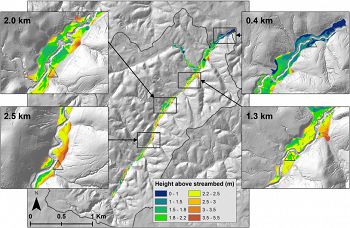Wade et al., 2020
Limited carbon contents of centuries old soils forming in legacy sediment
Wade, A., D.D. Richter, A. Cherkinsky, C.B. Craft, P.R. Heine (2020)
Geomorphology 354: 107018
-
Calhoun, GRAD STUDENT
-
Calhoun, INVESTIGATOR
-
Calhoun, INVESTIGATOR
-
Calhoun, STAFF
Abstract
Fig. 3. Map of floodplain height (in color) within Holcombe's Branch based on manual delineation from LiDAR-derived 1 m2 DEM. Colored values represent floodplain height above stream channel. Inset figures show reach-scale floodplain height, labeled by distance upstream. Triangles mark locations of vegetation plots.
Accelerated erosion from European agriculture overwhelmed transport capacities of relatively low-gradient Piedmont watersheds and triggered widespread and massive sediment deposition on floodplains, referred to as legacy sediments. While erosion-driven soil loss on the Southern Piedmont landscape has been widely studied, the resultant legacy sediments deposited on hillslopes, floodplains, and in channels appear remarkably understudied. In the interim between deposition and future remobilization, legacy sediments are undergoing soil formation in ways that impact carbon stocks, nutrient retention, and a number of other soil-sediment functions. Here, we use a pedological framework to understand the dynamics of these legacy sediments by constraining the time since deposition and redevelopment of vegetation and the soil profile. In this study, we characterized the properties of legacy sediment and buried, pre-legacy sediment alluvium, established the timing of legacy sediment deposition and its volume in a 600-ha watershed, and analyzed the impact of accelerated sedimentation on floodplain soil carbon (SOC) storage.
We found alluvial legacy sediment in the 6 km2 Holcombe's Branch watershed to range in thickness from 0.35 to 1.25 m, averaging 1.01 m in depth (n = 20, CV = 19%). Radiocarbon (14C) dates from buried wood indicate that accelerated deposition began by the mid-1800s. During the next century, deposition rates increased and peaked at levels up to 40× higher than contemporary sedimentation rates. By the mid-1900s, accelerated deposition rates had slowed significantly, as indicated by surficial distributions of 1960s fall-out 137Cs in sediments. Upstream floodplains are today less frequently flooded and function as abandoned floodplains, or terraces. In contrast, downstream sites remain active floodplains and zones of deposition. A century of pedogenesis has formed acidic, well-drained Entisols, characterized by incipient, redeveloping A horizons over coarse-textured C horizons. Buried, pre-legacy sediment alluvium have well-developed redox features, are lower in hue and chroma than legacy sediments, and occasionally have moderate to strong aggregate structure. A century-old mixed pine-hardwood forest has diminished subsoil carbon stocks and created a shallow vertical distribution of SOC stocks, that total 95 Mg C ha−1 (CV = 25%) in the upper 2 m. Legacy sediments have nearly doubled alluvial sediment in the catchment and account for 55% of soil carbon stock. Coarse texture and porous legacy sediment-soils limit accumulation of mineral-associated soil carbon. A-horizon morphology was preserved in buried A horizons underlying legacy sediment, yet these horizons did not account for significant SOC stocks at depth. Depth profiles of active, light-fraction organic carbon revealed differences in SOC preservation between upstream and downstream sites. The hydrogeomorphic change responsible for this difference - from abandoned legacy sediment terraces upstream to active sedimentation on floodplains downstream – will continue to impact soil-sediment dynamics and functioning. Time since last deposition and revegetation are dominant forces in SOC dynamics, while gradients in soil moisture may be creating subtle longitudinal patterns in SOC preservation at depth.
Citation
Wade, A., D.D. Richter, A. Cherkinsky, C.B. Craft, P.R. Heine (2020): Limited carbon contents of centuries old soils forming in legacy sediment. Geomorphology 354: 107018. DOI: 10.1016/j.geomorph.2019.107018
 This Paper/Book acknowledges NSF CZO grant support.
This Paper/Book acknowledges NSF CZO grant support.
Explore Further





